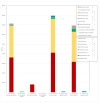Effectiveness of 0.66% Povidone-Iodine Eye Drops on Ocular Surface Flora before Cataract Surgery: A Nationwide Microbiological Study
- PMID: 34069600
- PMCID: PMC8160713
- DOI: 10.3390/jcm10102198
Effectiveness of 0.66% Povidone-Iodine Eye Drops on Ocular Surface Flora before Cataract Surgery: A Nationwide Microbiological Study
Abstract
A multicenter, nonrandomized, prospective, controlled study was conducted to evaluate, as perioperative prophylactic treatment, the anti-infective effectiveness of 0.66% povidone-iodine eye drops (IODIM®) against the bacterial flora of the conjunctival surface of patients who undergo cataract surgery. Eye drops containing 0.66% povidone-iodine were applied to the eye undergoing cataract surgery; the untreated contralateral eye was used as control. One hundred and twenty patients set to receive unilateral cataract surgery were enrolled in 5 Italian Ophthalmology Centers and pretreated for three days with 0.66% povidone-iodine eye drops. The contralateral eye, used as control, was left untreated. Conjunctival swabs of both eyes were collected at the baseline visit and after three days of treatment, just before the cataract surgery. A qualitative and quantitative microbiological analysis of bacterial presence was evaluated by means of bacterial culture, followed by identification. Methicillin resistance determination was also performed on staphylococci isolates. Bacterial load before and after treatment of the eye candidate for cataract surgery was evaluated and compared to the untreated eye. A reduction or no regrowth on the culture media of the bacterial load was observed in 100% of the study subjects. A great heterogenicity of bacterial species was found. The 0.66% povidone-iodine eye drops, used for three days prior to cataract surgery, were effective in reducing the conjunctival bacterial load. The 0.66% povidone-iodine eye drops (IODIM®) might represent a valid perioperative prophylactic antiseptic adjuvant treatment to protect the ocular surface from microbial contamination in preparation of the surgical procedure.
Keywords: antiseptic prophylactic treatment; cataract; endophthalmitis; ocular surgery; povidone iodine.
Conflict of interest statement
Rosario Musumeci received research funding from Medivis srl (Catania, Italy) in the past years, but it was not related to this study. No conflicting relationship exists for any other author. The funders of Rosario Musumeci had no role in the design of the study; in the collection, analyses, or interpretation of data; in the writing of the manuscript, or in the decision to publish the results.
Figures


Similar articles
-
Cataract Surgery by Intraoperative Surface Irrigation with 0.25% Povidone-Iodine.J Clin Med. 2021 Aug 16;10(16):3611. doi: 10.3390/jcm10163611. J Clin Med. 2021. PMID: 34441906 Free PMC article. Review.
-
Effect of Liposomal-Lactoferrin-Based Eye Drops on the Conjunctival Microflora of Patients Undergoing Cataract Surgery.Ophthalmol Ther. 2023 Apr;12(2):1315-1326. doi: 10.1007/s40123-023-00673-5. Epub 2023 Feb 24. Ophthalmol Ther. 2023. PMID: 36826753 Free PMC article.
-
The Effectiveness of 0.6% Povidone Iodine Eye Drops in Reducing the Conjunctival Bacterial Load and Needle Contamination in Patients Undergoing Anti-VEGF Intravitreal Injection: A Prospective, Randomized Study.J Clin Med. 2019 Jul 13;8(7):1031. doi: 10.3390/jcm8071031. J Clin Med. 2019. PMID: 31337003 Free PMC article.
-
In vivo antimicrobial activity of 0.6% povidone-iodine eye drops in patients undergoing intravitreal injections: a prospective study.Sci Rep. 2021 Dec 2;11(1):23271. doi: 10.1038/s41598-021-02831-w. Sci Rep. 2021. PMID: 34857862 Free PMC article.
-
Povidone-iodine concentration and dosing in cataract surgery.Surv Ophthalmol. 2018 Nov-Dec;63(6):862-868. doi: 10.1016/j.survophthal.2018.05.002. Epub 2018 May 18. Surv Ophthalmol. 2018. PMID: 29778494 Review.
Cited by
-
Comparison of iodine compounds and levofloxacin as postoperative instillation; conjunctival bacterial flora and antimicrobial susceptibility following cataract surgery.Jpn J Ophthalmol. 2024 Nov;68(6):702-708. doi: 10.1007/s10384-024-01117-8. Epub 2024 Sep 6. Jpn J Ophthalmol. 2024. PMID: 39240403
-
The Use of Venous Catheter and Irrigation with Povidone-Iodine 0.6% in Patients with Punctal and Proximal Canalicular Stenosis: Preliminary Report.J Clin Med. 2024 Feb 26;13(5):1330. doi: 10.3390/jcm13051330. J Clin Med. 2024. PMID: 38592157 Free PMC article.
-
Incidence, Prophylaxis and Prognosis of Acute Postoperative Endophthalmitis After Cataract Surgery: A Multicenter Retrospective Analysis in Northern China from 2013 to 2019.Infect Drug Resist. 2022 Jul 27;15:4047-4058. doi: 10.2147/IDR.S332997. eCollection 2022. Infect Drug Resist. 2022. PMID: 35924017 Free PMC article.
-
Cataract Surgery by Intraoperative Surface Irrigation with 0.25% Povidone-Iodine.J Clin Med. 2021 Aug 16;10(16):3611. doi: 10.3390/jcm10163611. J Clin Med. 2021. PMID: 34441906 Free PMC article. Review.
-
Comparative Evaluation of Bandage Contact Lenses and Eye Patching after Bilateral Cataract Surgery.J Ophthalmol. 2021 Aug 13;2021:2873543. doi: 10.1155/2021/2873543. eCollection 2021. J Ophthalmol. 2021. PMID: 34422403 Free PMC article.
References
LinkOut - more resources
Full Text Sources

